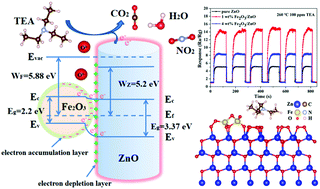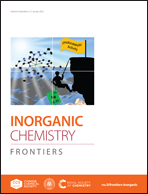The modification effect of Fe2O3 nanoparticles on ZnO nanorods improves the adsorption and detection capabilities of TEA†
Abstract
Surface modification is a simple and efficient method to enhance the gas sensing properties of semiconductor materials. In this paper, Fe2O3 nanoparticle-decorated ZnO nanorods are successfully fabricated by a facile two-step synthesis method. The SEM, TEM and XPS results indicate that the Fe2O3 nanoparticles grow directly on the surface of ZnO nanorods. The gas sensing properties of pure ZnO and Fe2O3/ZnO nanocomposites have been systematically analyzed. The gas response value of a 1 wt% Fe2O3/ZnO sample is 14.5 to 100 ppm triethylamine (TEA) at the optimal operating temperature of 260 °C, which is about 3 times that of pure ZnO (5.0). In addition, the 1 wt% Fe2O3/ZnO sensor reflects a rapid response/recovery time (1 s/14 s). The density functional theory (DFT) simulation results confirm that after the Fe2O3 cluster modifies the surface of ZnO, the atomic position at the interface changes significantly and the structure of Fe2O3/ZnO has the lowest adsorption energy for TEA molecules; these are the key factors for improving the gas sensitivity of the composite sample.

- This article is part of the themed collections: 2021 Inorganic Chemistry Frontiers Review-type Articles and 2021 Inorganic Chemistry Frontiers HOT articles


 Please wait while we load your content...
Please wait while we load your content...